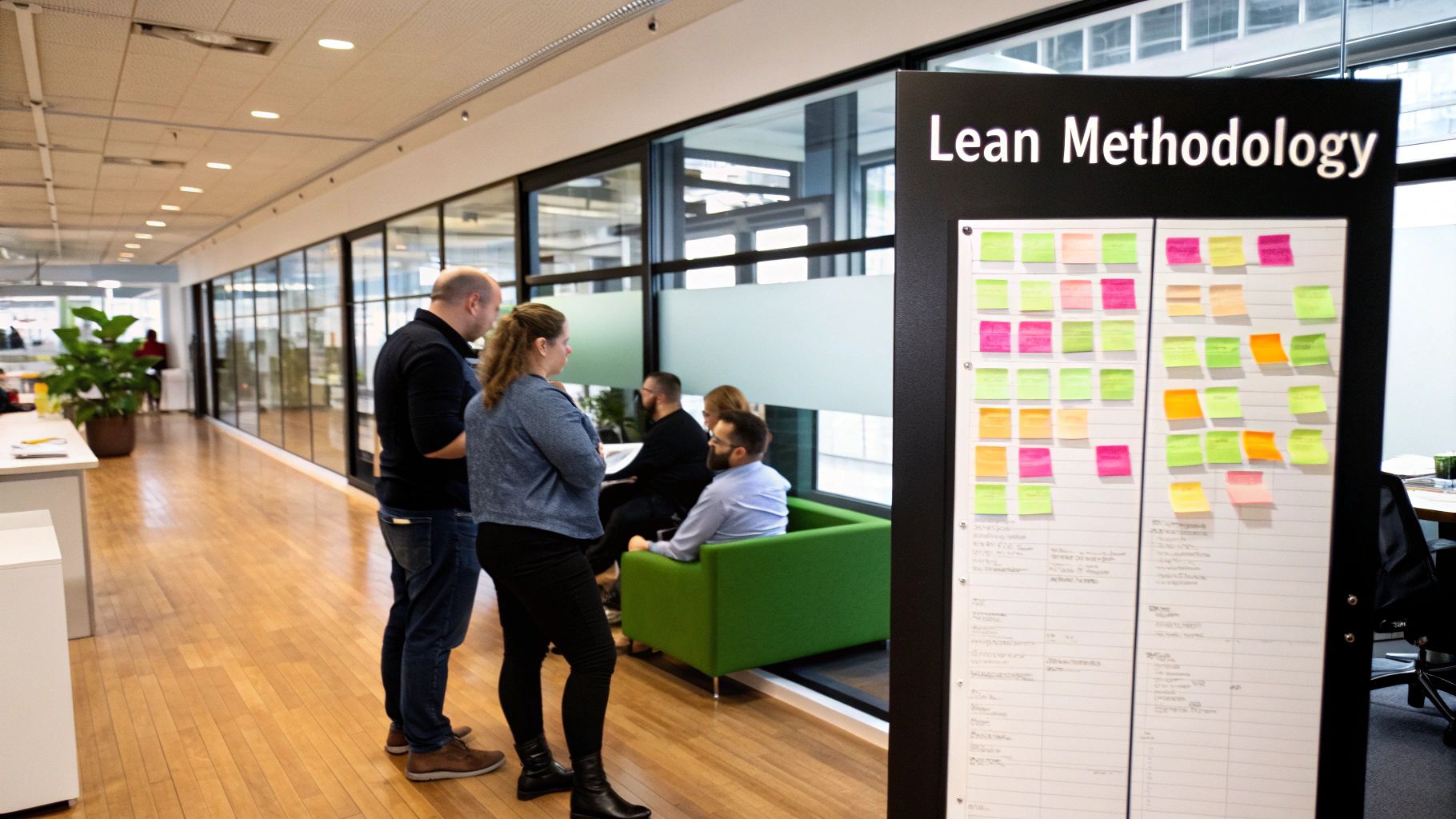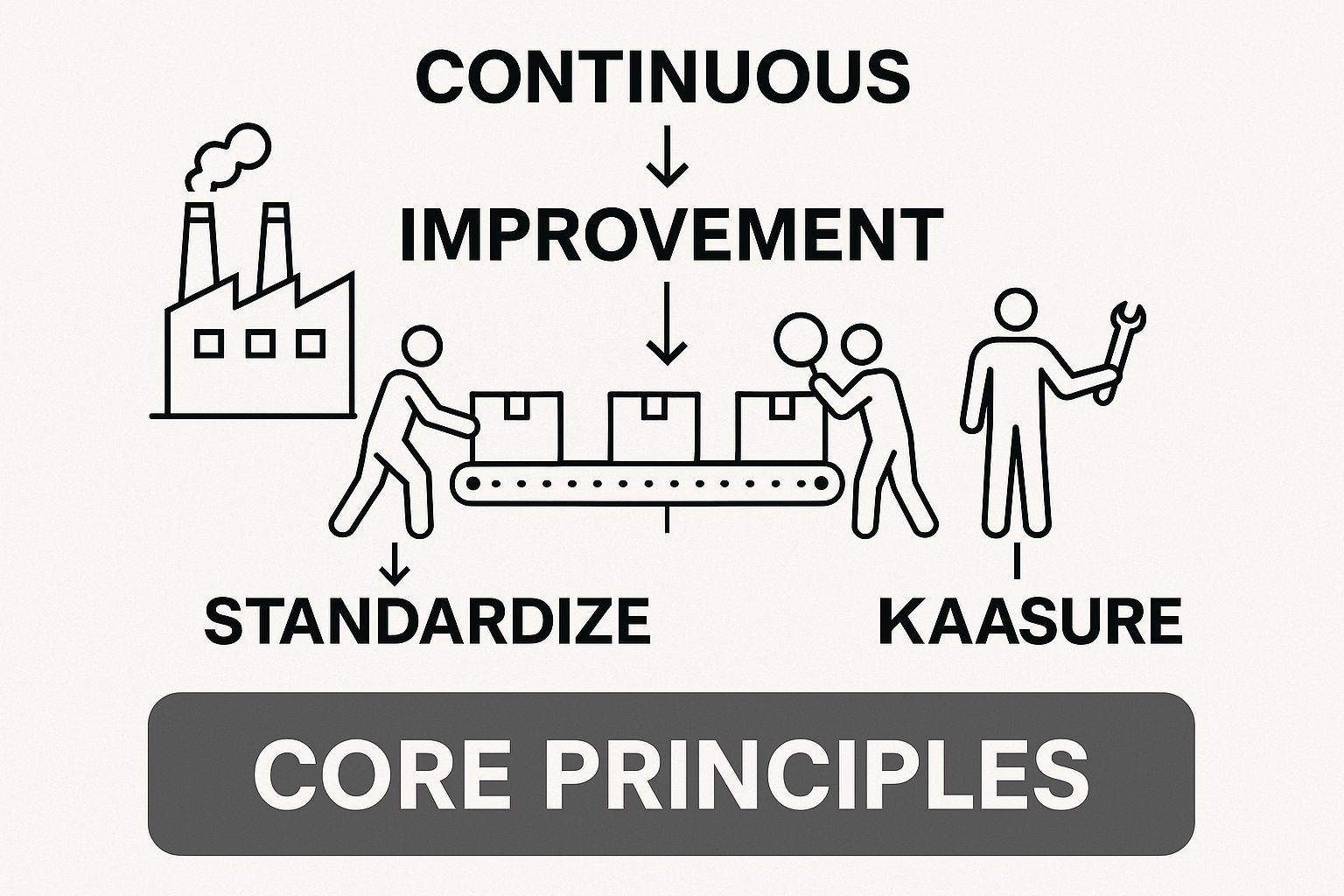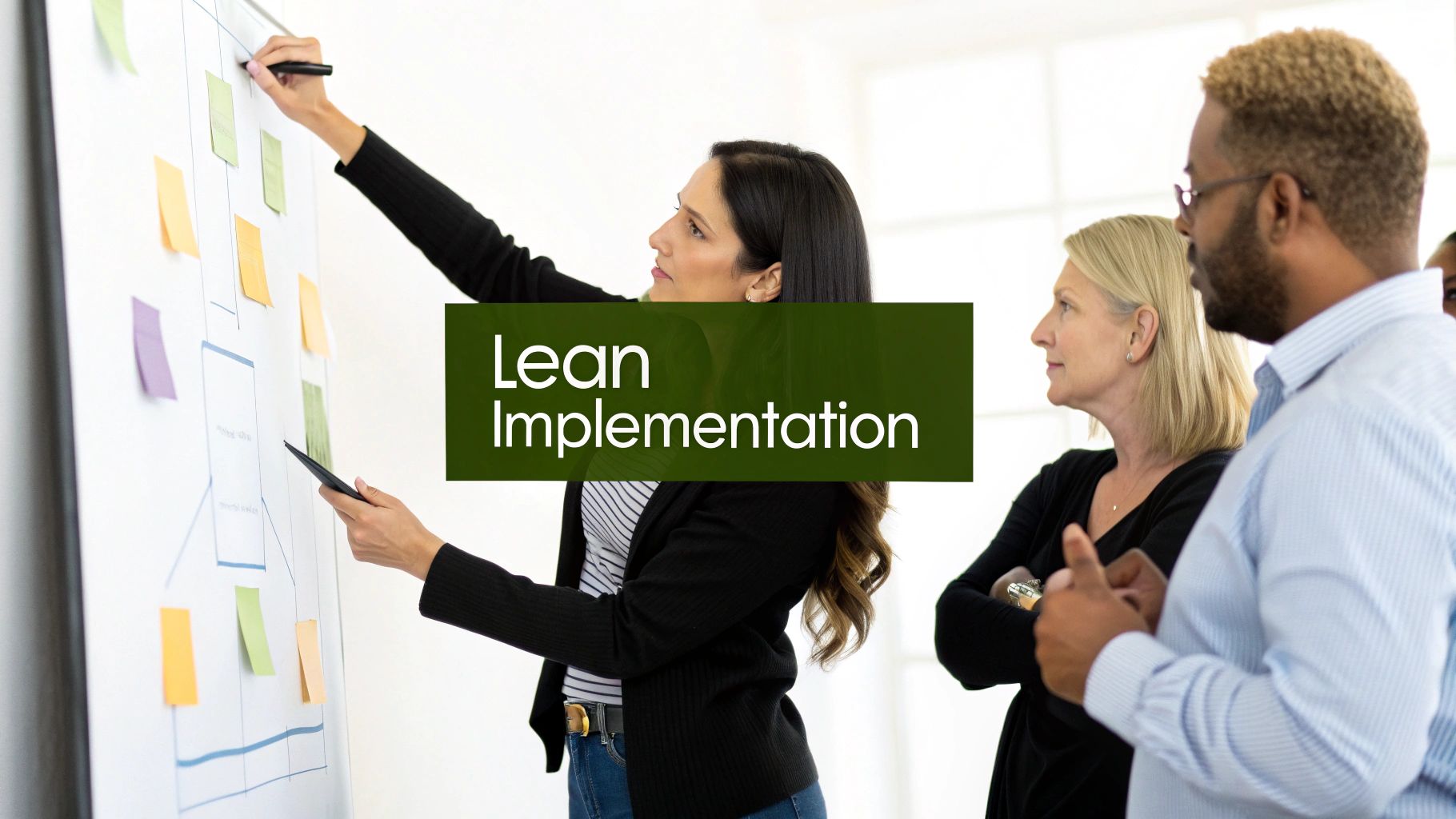What is Lean Methodology? A Complete Guide to Business Efficiency
Let's cut through the buzzwords. At its core, the lean methodology is a powerful way of thinking about your business. It’s all about a relentless focus on delivering maximum value to your customers by stripping away anything and everything that doesn't contribute to that goal.
This isn’t about cutting corners or slashing budgets. It’s about building an incredibly efficient, smart system where every single action, every feature developed, and every minute spent is purposeful. If it doesn't solve a customer's problem or make their experience better, it's considered waste—and you find a way to get rid of it.
Defining Lean Without the Jargon

To really get what lean is about, you need to shift your perspective. Stop looking at your business as a collection of separate departments and start seeing it as one continuous flow of value from your team to your customer.
The one question you have to constantly ask is, "Does this step actually add value for the person paying us?" If the answer is no, then the lean approach is to figure out how to minimize it, automate it, or eliminate it completely.
Think of it like a professional chef's kitchen. A lean kitchen only fires up a dish when an order comes in, using precisely the ingredients needed to craft a perfect meal. In contrast, a wasteful kitchen might cook huge batches of food that sit under heat lamps, lose their quality, and often get tossed. The first is all about delivering fresh, on-demand value. The second is just burning time and money. That’s the mindset shift lean brings to the table.
Lean Methodology at a Glance
To quickly grasp the core ideas, this table breaks down the fundamental concepts of lean thinking.
| Concept | Core Idea | Example in a SaaS Business |
|---|---|---|
| Value | Define what the customer truly cares about and is willing to pay for. | Building a new reporting feature because customers have explicitly requested it to solve a specific business problem. |
| Value Stream | Map all the steps required to deliver that value, from concept to customer. | Visualizing the entire process from a user suggesting a feature to that feature being coded, tested, and deployed. |
| Flow | Ensure the value stream moves smoothly without interruptions, delays, or bottlenecks. | Automating the QA testing process to prevent new code from getting stuck waiting for manual review for days. |
| Pull | Don't create anything until the customer requests it; work is "pulled" by demand. | Developing new integrations only after a significant number of users or high-value prospects have confirmed a need. |
| Perfection | Continuously strive to improve the process by eliminating waste. | Holding regular team retrospectives to identify small inefficiencies in the development cycle and fix them immediately. |
This framework isn't just a set of instructions; it's a new lens through which to view every single aspect of your operations.
The Mindset of Continuous Improvement
Here’s the thing about lean: it’s not a one-and-done project. You don't just "go lean" and check a box. It's a deep-seated commitment to continuous improvement, a concept the Japanese call Kaizen. The whole idea is that small, consistent, positive changes stack up over time to create massive results.
This philosophy empowers every single person on your team, from the C-suite to the newest hire, to spot problems and take initiative to solve them. It fundamentally changes the culture.
Instead of people just showing up to do their assigned tasks, they start actively looking for better, smarter ways to work. This culture is built on a few key pillars:
- Customer-Centric Value: You define what’s valuable based on what the customer needs, not what your internal teams think is cool.
- Process Optimization: You get obsessed with finding and crushing bottlenecks, delays, and pointless steps that slow everyone down.
- Team Empowerment: You give your people the trust, tools, and authority to make improvements in their own work.
By focusing relentlessly on the flow of value to the customer, lean helps organizations become more agile, responsive, and incredibly resilient. It’s less a rigid rulebook and more a flexible framework for thinking critically about how you get things done.
Lean vs. Other Methodologies
It's easy to lump lean in with other process improvement strategies, but its focus is distinct. While it shares some goals with things like business process reengineering, their approaches are worlds apart. You can learn more about that in our guide on what is business process reengineering.
The key difference? Lean champions incremental, continuous adjustments that come from the ground up. It avoids the radical, top-down overhauls that can disrupt an entire organization. This cultural commitment to always getting a little bit better, every single day, is what makes lean such a powerful and sustainable strategy for long-term growth.
The Story Behind Lean Thinking
To really get what lean methodology is all about, we have to look past the latest business fads and travel back in time. Lean isn't some new-fangled idea from a Silicon Valley startup; it's a battle-tested philosophy born from intense pressure and a whole lot of ingenuity. The story starts in the factories of post-war Japan, a nation struggling with scarce resources and the massive task of rebuilding its industry.
At the heart of this story is Toyota. While American auto giants were conquering the world with mass production, Toyota was playing a completely different game. They didn't have the cash, the space, or the raw materials to go head-to-head. But this very constraint became their secret weapon, forcing them to completely rethink manufacturing.
Instead of churning out huge batches of cars and just hoping they’d sell, Toyota needed a system that was quick on its feet, efficient, and obsessed with quality. This need gave birth to the Toyota Production System (TPS), the direct ancestor of modern lean thinking.
The Birth of the Toyota Production System
The masterminds behind TPS, people like Taiichi Ohno and Eiji Toyoda, didn't just copy American methods. They studied them, then tweaked them for their own reality. They built their entire system around one powerful idea: eliminating muda, the Japanese word for waste. They saw anything that used up resources without adding value for the customer as an enemy to be eliminated.
This went way beyond just saving a few bucks on materials. It was a complete overhaul of how they saw the production line.
- Waiting: A worker standing around waiting for the next part? That's waste.
- Overproduction: Making more cars than you have orders for? That's waste.
- Defects: Building a faulty part that needs to be fixed or tossed? That's a huge waste.
By hunting down and stamping out these inefficiencies one by one, Toyota created a system that could build better cars, faster, and with fewer resources. This relentless focus on creating a smooth, uninterrupted flow of value—from a pile of steel to a happy customer—became the bedrock of lean.
From the Factory Floor to the Modern Office
The principles Toyota pioneered were so powerful they started turning heads all over the world. The term 'lean manufacturing' first hit the scene in the 1988 book 'The Machine That Changed the World,' which detailed a massive study of the global auto industry. This book put a spotlight on the stunning efficiency of the Toyota Production System and helped its ideas spread far beyond Japan. By the 1990s, giants like Boeing and General Electric were using lean practices to get an edge. You can dig deeper into this history and its global spread by exploring more on the evolution of lean manufacturing.
What began on the noisy factory floor turned out to be incredibly versatile.
The core idea of identifying value from the customer's perspective and eliminating everything else is universal. It applies just as well to writing code, managing a sales pipeline, or onboarding a new client as it does to assembling a car.
This is exactly why understanding where lean comes from is so crucial. It’s not just a toolkit; it's a powerful mindset. It's a philosophy of continuous improvement forged in tough times, centered on creating more value with less work—a concept that’s more important today than ever before.
Mastering the Five Core Lean Principles
The Lean methodology isn't just a philosophy; it’s a practical framework built on five core principles. Think of them as a roadmap, guiding your business from figuring out what customers truly want to continuously getting better at how you deliver it. They provide the structure for turning the abstract idea of "eliminating waste" into a daily, actionable practice.
This diagram shows how these principles create a foundation for continuous improvement.

Each step logically builds on the one before it, creating a powerful system for optimizing your processes from start to finish. Let's break them down.
1. Specify Value From the Customer's Viewpoint
Everything in the Lean world begins and ends with the customer. The first principle, Specify Value, forces you to answer a critical question: what is the customer really paying for? It’s not about what your team thinks is cool or what you enjoy building. Value is defined exclusively by the person using your product.
Any activity, feature, or process that doesn't directly solve a customer's problem is, by definition, waste. This takes a deep understanding of your market and a willingness to challenge your own assumptions.
For a B2B SaaS company, this means prioritizing a new integration because it fixes a major workflow headache for 75% of your enterprise clients. It doesn't mean adding a minor UI tweak that only a few internal stakeholders asked for. Value is the anchor for everything else you do.
2. Map the Value Stream
Once you know what value is, the next step is to map every single action it takes to deliver it. This entire journey, from the first spark of an idea to the final product in the customer's hands, is the Value Stream. This isn't just a high-level flowchart; it’s a granular look at your entire process, including both the steps that add value and those that don't.
The goal here is to make the invisible visible. By mapping the value stream, you can see exactly where work gets stuck, where handoffs are clumsy, and where delays creep in. It shines a bright light on the hidden waste that silently drains your resources.
A value stream map for a new software feature would track everything from the initial product brief, design mockups, and coding sprints to QA testing, deployment, and the customer announcement. Seeing it all laid out often reveals a shocking amount of "waiting around" time between the actual work.
3. Create Uninterrupted Flow
With a clear map in hand, the third principle is all about making the work Flow. The ideal is for value to move smoothly and continuously through your process without any interruptions or bottlenecks. Think of it like a river—any dam, like a lengthy approval process or a technical bottleneck, stops the flow.
In a Lean system, you systematically dismantle those dams. This means breaking down departmental silos, automating what you can, and creating cross-functional teams that can see a task through from start to finish without long handoffs.
To make this happen, many leaders turn to a variety of business process improvement methods that focus on systematically removing these obstacles. The smoother the flow, the faster you can get value to your customers.
4. Establish a Pull System
Most companies operate on a "push" system. They build a product based on a forecast and then push it out to the market, hoping people buy it. A Pull System flips that script entirely. Nothing gets made until the customer asks for it.
This is the very essence of just-in-time production. Work is "pulled" through the system based on actual, real-time demand, not on a guess. This principle hammers away at overproduction, which many consider the most damaging type of waste because it creates so many others, like excess inventory and wasted effort.
- Restaurant Analogy: A cook doesn't start firing up a steak until a customer places an order. That order "pulls" the work through the kitchen.
- SaaS Example: A dev team doesn't start building a massive new feature until they have validated demand from several high-value customers. Those requests pull that item from the backlog into an active sprint.
This approach makes sure you're always working on something that has a confirmed, immediate purpose.
5. Pursue Perfection Through Kaizen
The final principle is the engine that drives the whole methodology: Pursue Perfection. Lean isn't a project you finish. It’s a deep-seated commitment to Kaizen, or continuous improvement. The goal is to weave the habit of spotting and eliminating waste into your company's cultural DNA.
This means creating an environment where every employee feels empowered to point out inefficiencies and suggest better ways of doing things. It involves using data to see how you're doing, holding regular team retrospectives, and constantly asking, "How can we make this just a little bit better today?"
Perfection isn't a destination you arrive at. It's the relentless pursuit of it. This mindset ensures your organization gets more efficient, agile, and customer-focused over time, turning the first four principles into a self-reinforcing cycle of excellence.
How to Spot and Eliminate the Eight Wastes
At its core, lean is all about relentlessly hunting down and eliminating waste. But what exactly is waste? It’s any activity that eats up resources but adds zero value from your customer's point of view.
To make this tangible, lean gives us a powerful framework: the Eight Wastes. While these were first identified on the factory floors of Toyota, they provide a surprisingly effective lens for spotting hidden costs and inefficiencies in any business, including a modern B2B SaaS company.
Think of them as leaks in your value pipeline. Once you learn to spot them, you can start plugging them for good. The easiest way to remember them is with the acronym DOWNTIME.
D for Defects
Defects are the most glaring form of waste. It’s any time your work isn’t done right the first time and needs a do-over.
In manufacturing, that's a faulty part. In the SaaS world, it’s a software bug that needs a patch, a clunky UI that frustrates users, or an inaccurate customer report.
Every defect forces you to spend time, money, and energy fixing a problem that should have been prevented. The cost isn't just the developer's salary; it's the support tickets, the hit to your reputation, and the very real risk of customer churn. The goal isn't to get better at fixing bugs—it's to build quality into the process from the very start.
O for Overproduction
Many lean experts consider Overproduction the most dangerous waste of all because it’s the one that gives birth to all the others. It’s the simple act of creating more of something than is immediately needed.
For a software company, this isn’t about a warehouse of unsold gadgets. It's about building features no one asked for, writing an entire library of help docs for a product that isn't finished, or running a marketing campaign for a launch that's months away. This "just-in-case" work ties up your best talent, bloats your product, and racks up technical debt—all with no guaranteed return.
W for Waiting
The waste of Waiting is any idle time where work is at a standstill. This is one of the most maddeningly common wastes in an office.
It’s the developer waiting for a code review. It's the marketing campaign stuck waiting for a final sign-off. It’s the sales team twiddling their thumbs while legal fine-tunes a contract. These delays create bottlenecks that choke the flow of value, push back revenue, and serve absolutely no purpose.
Lean thinking relentlessly targets these queues. The objective is to make the value stream flow smoothly and continuously, eliminating the "hurry up and wait" cycles that plague so many organizations.
N for Non-Utilized Talent
Failing to tap into the full brainpower of your team is the waste of Non-Utilized Talent. It’s a silent killer of morale and innovation.
This waste happens when leaders micromanage their best people, when great ideas from frontline employees are ignored, or when someone is stuck in a role that completely misses their true skills. Think of a senior engineer assigned to mind-numbing data entry, or a support rep's brilliant idea for improving customer onboarding getting lost in the shuffle.
Your team is your single greatest asset. Not empowering them to help improve the business is a massive missed opportunity.
The Rest of DOWNTIME
To get a complete picture, we need to translate the remaining four wastes from their manufacturing origins into terms that make sense for a SaaS business. This is where many teams get stuck, but the parallels are surprisingly clear.
Here’s a quick breakdown to help you spot them in your own operations.
The Eight Wastes From Factory to SaaS
| Waste (DOWNTIME) | Manufacturing Example | B2B/SaaS Example |
|---|---|---|
| Transportation | Moving parts between workstations unnecessarily. | Excessive handoffs between dev, QA, and product teams. |
| Inventory | A warehouse full of unsold goods tying up capital. | A massive backlog of unstarted user stories or unused software licenses. |
| Motion | A worker walking across the factory to get a tool. | A designer clicking through 10 screens to perform a 2-click action. |
| Extra-Processing | Polishing a part that the customer will never see. | Building "gold-plated" features nobody needs or generating reports nobody reads. |
By learning to see your daily work through the DOWNTIME lens, you move beyond abstract ideas about "being more efficient." You start seeing specific, actionable opportunities to make your business faster, stronger, and more focused on what your customers truly value.
Putting Lean Tools into Practice

Knowing the philosophy behind lean is one thing, but actually putting it to work in your business? That takes a practical toolkit. These tools are the bridge between theory and reality, helping your teams see their work clearly, spot bottlenecks, and make improvements that actually stick. For any B2B or SaaS leader, these aren't just for factory floors; they’re powerful ways to sharpen every part of your operation.
One of the easiest tools to start with, yet one of the most powerful, is the Kanban board. In its simplest form, it’s just a visual way to track your workflow, usually with columns like "To Do," "In Progress," and "Done." As tasks get worked on, they move across the board from left to right.
The real magic of Kanban, though, comes from its ability to create a "pull" system by limiting the amount of work in progress (WIP). This simple constraint stops teams from getting swamped and instantly shines a light on where things are getting stuck. If the "In Progress" column is at its limit, nobody can pull in new work until something moves to "Done"—forcing the team to swarm the bottleneck and get it cleared.
Visualizing Value with Kanban and VSM
Think about a marketing team using a tool like Trello or Asana as their Kanban board. Their columns might be "Idea Backlog," "Content Writing," "Design," and "Published." By setting a WIP limit of, say, three articles for the "Content Writing" stage, the team leader makes sure writers can truly focus and produce quality work instead of juggling ten assignments at once.
For a deeper dive, there's Value Stream Mapping (VSM). This is a more involved exercise where you literally draw out every single step of a process—from the moment a customer makes a request to the final delivery—to find and measure waste. While Kanban shows you where a bottleneck is, VSM helps you understand why it’s happening.
For a SaaS company, mapping out the customer onboarding process might reveal that a staggering 40% of the total time is spent just waiting for manual account verification. That's a huge insight. It makes it crystal clear that automating that step is the single biggest improvement you can make to reduce friction and keep customers happy.
Driving Continuous Improvement with Kaizen and 5S
While Kanban and VSM help you see and analyze your work, Kaizen is the tool for actively making it better. Kaizen, which translates to "continuous improvement," is all about making small, smart changes regularly. This often happens through a "Kaizen event," which is basically a focused workshop where a team from different departments gets together for a few days to tackle one specific problem.
They map the current process, brainstorm fixes, implement one, and then measure the results. This gives employees the power to solve the problems they see every day, building a culture of ownership and proactive thinking. A key part of this is continuously optimizing invoice processing workflow to root out and eliminate inefficiencies.
Working hand-in-glove with Kaizen is the 5S system, a method for creating a clean, organized, and efficient workspace. The five S's are:
- Sort (Seiri): Get rid of everything you don’t need.
- Set in Order (Seiton): Give everything you do need a specific home.
- Shine (Seiso): Keep the workspace and tools clean.
- Standardize (Seiketsu): Create clear rules for the first three S's.
- Sustain (Shitsuke): Build the habits to make 5S stick for the long haul.
In the digital world, this means organizing shared drives, creating clear file naming rules, and archiving old projects to cut down on digital clutter. A well-organized digital space minimizes the "waste of motion" that happens when people have to hunt for information. You can dig deeper into identifying these systemic issues with our guide on https://makeautomation.co/what-is-process-mining/.
Common Questions About Lean Methodology
As you start to dig into what Lean methodology really is, a few questions always seem to surface. This isn't just about learning a new set of buzzwords; it's a fundamental shift in how you see your entire operation. Getting these common questions cleared up early is the key to moving forward with confidence and avoiding some classic rookie mistakes.
Let's walk through some of the most frequent questions I hear from B2B and SaaS leaders when they first start exploring Lean. I'll give you direct, practical answers to cut through the noise so you can focus on what actually matters.
What’s the Real Difference Between Lean and Agile?
This one comes up all the time. It's easy to get Lean and Agile confused because they're often mentioned in the same breath and both are obsessed with delivering value quickly.
The simplest way I can put it is this: Lean is a broad philosophy, while Agile is a specific framework for getting work done, especially in software development.
Lean is all about maximizing customer value by relentlessly hunting down and eliminating waste from the entire system. It forces you to look at the whole value stream—from the first conversation with a prospect to the final delivery of your service—and ask, "How can we make this whole journey smoother and more efficient?"
Agile, on the other hand, is a project management approach that grew out of Lean principles. It's focused on iterative development, constant customer feedback, and adapting to change on the fly. You could say it's a way of applying Lean thinking specifically to the beautiful chaos of building complex products.
Think of it this way: Lean is the 'why'—the overarching mission to eliminate waste and maximize value. Agile is one of the most popular 'hows'—a specific set of practices like sprints and stand-ups designed to achieve that goal in a development team.
How Can a Non-Manufacturing Company Start with Lean?
It's true, the principles of Lean were born on the Toyota factory floor, but their power is universal. For a B2B or SaaS company, your "product" isn't a car; it's software, a service, or a customer solution. The trick is to translate the core ideas into your world.
You don't need a massive, company-wide initiative. Here are a few practical first steps you can take today:
- Start small with a pilot project. Don't try to boil the ocean. Pick one specific, measurable process that’s a known pain point—maybe it's the customer onboarding experience or the handoff from sales to the success team—and apply Lean principles there first.
- Visualize your workflow. Get a simple Kanban board up for a single team. Just the act of making the work visible highlights bottlenecks and sparks conversations about flow. It's a tiny investment that delivers immediate insights.
- Hold a "waste-finding" workshop. Gather a cross-functional team and introduce them to the eight wastes (DOWNTIME). Then, just ask them to brainstorm examples of each waste in their daily work. You will be absolutely stunned by the low-hanging fruit they uncover.
The goal here isn't perfection right out of the gate. It's about building momentum by proving that these ideas deliver real, tangible results, even on a small scale.
Is Lean Just About Cutting Costs?
This is probably the most dangerous misconception out there, and it can kill a Lean initiative before it even gets started. While cost reduction is often a very nice outcome of implementing Lean, it is never the primary goal. True Lean thinking is an obsession with creating more value for the customer.
Think about it: typical cost-cutting focuses on the expense column. It leads to short-sighted decisions like slashing headcount or switching to cheaper tools, which almost always harms quality and morale. Lean works from the other direction.
By systematically removing wasteful activities—time spent fixing bugs, days waiting for approvals, hours building features nobody uses—you naturally reduce the costs associated with them. The focus stays positive: how can we serve our customers better and faster? The savings are just a happy byproduct of becoming a more effective organization.
What Is the Biggest Challenge in Adopting a Lean Culture?
The tools are easy. Kanban boards, value stream maps, the 5 Whys—anyone can learn these in an afternoon. The single biggest challenge, by a long shot, is the cultural shift. Lean isn't a process you install like new software; it's a mindset you have to cultivate, day in and day out.
The toughest part is moving from a traditional, top-down, command-and-control management style to one of empowerment and continuous improvement. It requires leaders to stop being the ones with all the answers and start becoming coaches who empower their teams to find the answers themselves.
This really boils down to three things:
- Building Psychological Safety: You have to create an environment where people feel safe to point out problems and suggest ideas without any fear of blame or punishment.
- Embracing Failure as Learning: Mistakes can't be seen as something to be punished. They have to be treated as valuable, data-rich opportunities to understand and improve the process.
- Leading with Humility: This means genuinely believing that the people doing the work are the true experts on how to improve it.
Overcoming this cultural resistance is the hardest part of the journey, but it’s also where the real magic happens. Without this foundational shift, any Lean tools you implement will just be window dressing, and you'll never see the results you're looking for.
Ready to eliminate waste and accelerate your growth? MakeAutomation specializes in helping B2B and SaaS businesses implement AI and automation to build scalable, efficient processes. Reclaim your time and boost your ROI by visiting the MakeAutomation website to learn how we can help.







